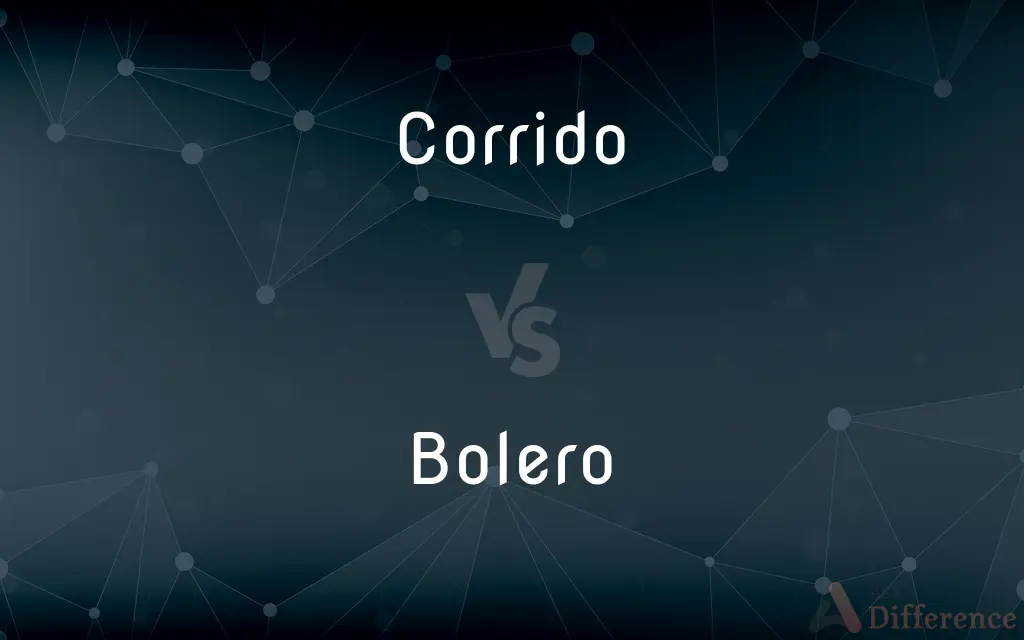Corrido vs. Bolero — What's the Difference?
By Maham Liaqat & Fiza Rafique — Updated on April 4, 2024
Corrido is Mexican ballad that narrates a story, of oppression, resistance, and social issues, with rhythmic and narrative structure. Bolero is slow-tempo Latin music genre focusing on love and romance, characterized by its lyrical and melodic expression.

Difference Between Corrido and Bolero
Table of Contents
ADVERTISEMENT
Key Differences
The corrido is a traditional Mexican narrative song and ballad form that typically tells a story, which could be about historical events, personal vendettas, or the challenges faced by the working class. Its origins trace back to the 19th century, serving not only as entertainment but also as a form of social commentary and a means to spread news. Bolero, originating in Cuba in the late 19th century, is a genre of slow-tempo Latin music that emphasizes romantic and emotional lyrics, often dealing with themes of love, betrayal, and longing.
Corridos often feature straightforward, repetitive melodies and are usually performed by ensembles that include guitars, accordions, and sometimes brass instruments. They are known for their narrative lyrics, often heroic or political, and their role in celebrating Mexican identity and resistance. Boleros, on the other hand, are characterized by their lush, romantic melodies, intricate harmonies, and are typically performed by small bands or soloists with guitars, piano, and light percussion, focusing on the emotional delivery of the lyrics.
The corrido has played a significant role in Mexican history and culture, evolving through different periods, such as the Mexican Revolution, where it was used to tell stories of heroes and battles, and into contemporary times, adapting to reflect current social issues. Bolero has also evolved, spreading throughout Latin America and influencing other music genres, becoming a fundamental part of Latin romantic music, celebrated for its poetic lyrics and emotional depth.
While both genres are important components of Latin American musical heritage, the corrido is more associated with narrative storytelling and social commentary, reflecting the struggles and stories of the Mexican people. Bolero, with its emphasis on romance and emotion, has a broader appeal in Latin America, touching on universal themes of love and heartbreak.
The performance contexts for corridos and boleros also differ, with corridos often performed in public spaces, during political rallies, or in social gatherings to share stories and messages. Boleros are more commonly performed in intimate settings, such as cafes, nightclubs, or in the home, creating a romantic atmosphere.
ADVERTISEMENT
Comparison Chart
Origin
Mexico, 19th century
Cuba, late 19th century
Themes
Historical events, social issues, resistance
Love, romance, emotional experiences
Musical Style
Narrative, often with a steady rhythm
Slow tempo, lyrical, focusing on melody and harmony
Instrumentation
Guitars, accordions, brass instruments
Guitars, piano, light percussion
Cultural Role
Social commentary, storytelling
Romantic expression, emotional connection
Performance Context
Public spaces, rallies, gatherings
Intimate settings, cafes, nightclubs
Lyrics
Storytelling, often political or heroic
Romantic, often about love and longing
Audience
Broad, with a focus on Mexican identity
Broad, across Latin America, focusing on romantic themes
Compare with Definitions
Corrido
A Mexican narrative song telling stories of revolution, heroism, and struggle.
The corrido of Pancho Villa narrates the exploits of the revolutionary leader.
Bolero
A genre of slow-tempo Latin music focusing on romance and emotion.
The bolero song expressed the depths of his unrequited love.
Corrido
Featuring a simple melody and narrative lyrics.
Corridos serve as musical newspapers, detailing significant historical events.
Bolero
Originating in Cuba, characterized by lyrical melodies.
Bolero has spread throughout Latin America, becoming synonymous with romantic music.
Corrido
Reflecting social and political issues.
Contemporary corridos discuss issues like immigration and social injustice.
Bolero
Typically performed with guitars and light percussion.
The band's rendition of the classic bolero captivated all with its emotional intensity.
Corrido
Often performed with guitars and accordions.
The band captured the audience with the corrido's stirring narrative.
Bolero
Emphasizing romantic lyrics and smooth melodies.
The bolero's lyrics spoke of love lost and the longing for reconciliation.
Corrido
A medium for cultural expression and resistance.
The corrido has evolved but remains a symbol of Mexican resilience.
Bolero
Creating a romantic and intimate atmosphere.
The couple danced closely to the sultry bolero, lost in the music's embrace.
Corrido
The corrido (Spanish pronunciation: [koˈrið̞o]) is a popular narrative metrical tale and poetry that forms a ballad. The songs are often about oppression, history, daily life for criminals, the vaquero lifestyle, and other socially relevant topics.
Bolero
Bolero is a genre of song which originated in eastern Cuba in the late 19th century as part of the trova tradition. Unrelated to the older Spanish dance of the same name, bolero is characterized by sophisticated lyrics dealing with love.
Corrido
A Mexican ballad or folk song.
Bolero
A very short jacket worn open in the front.
Corrido
(music genre) A Mexican or Mexican-American ballad or folk song.
Bolero
A lively Spanish dance in triple meter.
Bolero
The music for this dance.
Bolero
A slow Latin American dance in triple meter.
Bolero
The music for this dance.
Bolero
(dance) A lively Spanish dance in 3/4 time; also an unrelated slower-tempo dance of Cuban origin, in 2/4 time.
Bolero
(fashion) A type of short, buttonless jacket or blouse, open or tied in front and ending at the diaphragm.
Bolero
(intransitive) To dance the bolero.
Bolero
A Spanish dance, or the lively music which accompanies it.
Bolero
A kind of small outer jacket, with or without sleeves, worn by women.
Bolero
Music written in the rhythm of the bolero dance
Bolero
A short jacket; worn mostly by women
Bolero
A Spanish dance in triple time accompanied by guitar and castanets
Common Curiosities
Can boleros be about themes other than love?
While boleros predominantly focus on love and romance, some explore themes of nostalgia, sorrow, and even social commentary, albeit less frequently than corridos.
Are corridos only popular in Mexico?
Corridos have their roots in Mexico but have gained popularity in other regions, especially among communities with Mexican heritage.
Why are corridos important to Mexican culture?
Corridos play a crucial role in preserving historical narratives, cultural identity, and social commentary, often reflecting the voice of the people and their struggles.
What distinguishes a corrido from a bolero?
Corridos are narrative ballads focusing on storytelling and social issues, while boleros are romantic songs emphasizing emotional and lyrical expression.
How have boleros influenced other music genres?
Boleros have influenced various music styles, including Latin jazz, salsa, and even pop music, through their romantic themes and melodic elements.
Do corridos and boleros appeal to different audiences?
While both genres can appeal broadly, corridos often resonate with those interested in social and historical narratives, whereas boleros primarily attract those drawn to romantic and emotional music.
How do performers convey the emotion in boleros?
Emotion in boleros is conveyed through expressive vocals, nuanced musical arrangements, and the intimate delivery of the lyrics, often highlighting the singer's emotional depth.
Can corridos and boleros use the same instruments?
While there can be overlap in instrumentation, such as the use of guitars, the arrangements and emphasis differ, with corridos often including accordions and brass, and boleros featuring piano and light percussion.
Have modern interpretations of boleros changed the genre?
Modern interpretations of boleros have experimented with arrangements and influences from other genres, but the core themes of romance and emotional expression remain central.
What role do corridos play in contemporary social movements?
Contemporary corridos continue to serve as a voice for social movements, documenting struggles, injustices, and the experiences of marginalized communities, adapting to reflect current issues.
Share Your Discovery

Previous Comparison
Crying vs. Wining
Next Comparison
Sagebrush vs. WormwoodAuthor Spotlight
Written by
Maham LiaqatCo-written by
Fiza RafiqueFiza Rafique is a skilled content writer at AskDifference.com, where she meticulously refines and enhances written pieces. Drawing from her vast editorial expertise, Fiza ensures clarity, accuracy, and precision in every article. Passionate about language, she continually seeks to elevate the quality of content for readers worldwide.














































